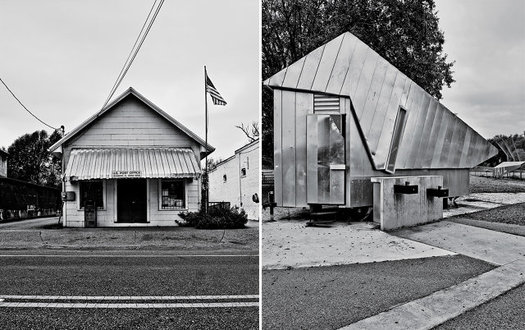
Photos by Adrian Gaut, Fast Company
The February issue of Fast Company includes my story on a subject that’s interested me for a long time: the many ambitious design and architecture projects that have played out, over 20 years, in Hale County, Alabama. It took me a long time to find the right home for this story, and a long time to report and write. (Although inevitably I ended up wishing I’d had more time — the number of enlightening conversations I had with a wide cross-section of people while working on this was astounding.)
Here is the setup paragraph for what the piece attempts to deal with:
The singular history of Hale County offers a chance to confront the most important questions that could be asked about design as catalyst. Are social designers most successful when they swoop in with the fresh thinking of outsiders? Or do they need to be embedded in the communities they aim to enhance? To use a business analogy, sometimes the rhetoric around social design suggests it can do for challenged communities what Jony Ive did for Apple. So what has really worked in Hale County? Has it improved the lives of the county's residents?
I bring this up here partly because readers of Design Observer may notice passing references to the Aspen Design Summit in 2009, and the Winterhouse Fourth Symposium on Design Education and Social Innovation, this past August 2013. I am only familiar with those (and the similar events in between) from afar, but from all I’ve read and heard about them, they embodied a holistic, thoughtful, and willing-to-be-critical approach to what's sometimes called the social design idea. And they seem premised on beliefs that while design is important, much depends on how design interacts with and learns from other fields, and also that learning from what's not working is as important as celebrating what does. In any case, I tried to operate with that spirit in this piece, albeit in a journalistic context that’s both narrower in scope and intended for an audience beyond the profession.
The story is now also online, and I’ve been getting steady feedback. Obviously I'm happy about readers who got the various things I was trying to say, and ask, with this story, and found it worthwhile.
I've also heard a bit of negative feedback — but that's been oblique, expressed privately, or both. So unfortunately there's nothing I can point (or respond) to. Suffice it to say, lots of thoughtful work has been done by lots of impressive people in Hale County, some of it successful and all of it with the best intentions. And of course I say all that in the piece. But my goal was to try to get beyond the usual three cheers — and I gather that in my attempts to answer the questions in that setup paragraph above, I may have stepped on some toes, and perhaps lost a friend or two.
At some point, though, genuine progress requires getting past the three cheers, and asking harder questions. At least that's what I think. Maybe you'll have a different take. The story is here.


Comments [4]
What you get feels like a Fast Company expose that editors drool over, given its tone and that DfSC has been on their hit list for years. You have to do better if you want to critique those that are actually dedicating their lives to doing something good. Yes it is complicated, but I would like to hear a conversation that asks the reader to think about what they would do to design for a community like Hale County.
Your headline asks, 'what has DfSC really "wrought"?' and imply that Walmart is more important than DfSC, based on someone you randomly meet. That is a dangerous opinion, that undervalues particular people and reinforces corporations. Poor areas are poor because they lack all three: good housing, transportation and jobs. And if you think that Walmart is a solution to economic ills, clearly you aren't paying attention.
What is New York City if it doesn't show the power of architecture and design to construct a physical and social dynamic that fosters economics? Again, just look at the particular buildings. I think it's called "Rural Studio" because it addresses issues about how people live outside of the city.... and these things are projects funded by students, so you have to judge their designs with an extra grain of salt--their naivety is their strength. Do you think Walmart would ever give a sh*t about hale county unless they could make money off of it?
If one person finds housing, what is that worth? What is the intellectual value to students of learning to build for context, even a poor one?
You never really interview anyone that has more than a passing familiarity with these projects and go for the easy targets like bamboo bikes, which something like Rural Studio would probably not go for.
Do good intentions get good results? No. But at a time when some critics encourage architects to spend more time on social media, is it possible that educational/student projects like Rural Studio (architects actually doing good) should be judged differently? Or at least judged for the quality of their projects and not use Hale County as an example of ALL OF SOCIAL DESIGN.
Other points:
1) Why lump Rural Studio, Project M and HERO together in this article? One quote from Dorr says "The reasons for the disconnect are both understandable and provincial, involving an accumulation of perceived slights. Best intentions don't always lead to the best relations." This makes them sound petty, but there seems to be a real difference between what Rural Studio and Project M are doing (building houses vs. bamboo bikes).
2) The most critical comment seems to be a generalized quote from a student paper. "The surprising result of this research was that these design organizations have produced very little measurable impact on the community as a whole. . . . The quality of life for the majority of the community has remained relatively the same." Huh? According to what?
And of course from André Muse, who had no direct connection to the projects at all.
3) Where are the individual accounts of people directly (not remotely) affected by the projects?
4) Where about the students from these programs? Don't you think it is valuable to learn the value of context, given the extremely damaging superficiality of digital media in todays design world?
01.21.14
03:50
01.22.14
10:53
One clarification: I did not write or imply that "Walmart is more important than DfSC."
Mike Lowe: I don't have anything to say about Facebook apps, but there's hardly a shortage of praise for social-design projects out there. In fact, you'll find some of it in my story.
01.22.14
11:44
http://places.designobserver.com/feature/lessons-from-the-front-lines-of-social-design/31998/
01.22.14
11:45